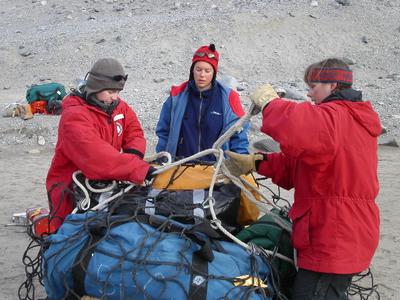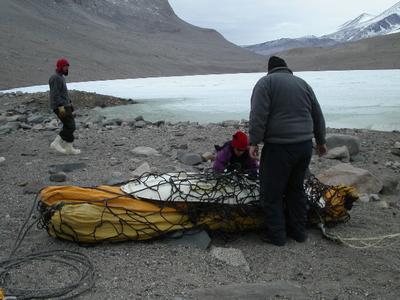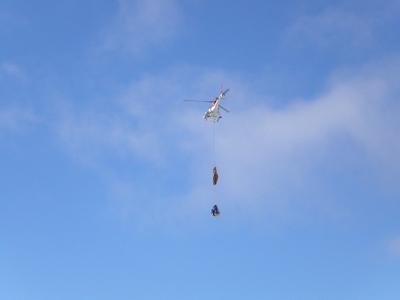28 January, 2003
Helicopters and Sling Loads
Some people hate change... often I think I look for it. I confess I am the
type of person that can get bored easily if curve balls aren't thrown my way
every once and a while. I guess that is one of the reasons that traveling
to Antarctica and living in a very different environment was so appealing to
me. Change also provides the opportunity for learning and growth. I love
learning new things, especially when I was not really focused on learning
something in parcticular. Sometimes it is fun to expect the unexpected.
Such has been the case here on the Ice.
I often thought about how fun it was going to be to dash about the Dry
Valleys in a helicopter, thinking about their unique maneuverability and how
we would be able to hover over ice and dart past giant glaciers. I pretty
much just thought about the ride and maybe having an opportunity to chat
with a pilot about what it is like to fly one, and how they are different
from flying a plane. I didn't give much thought or attention as to how all
our equipment would get from campsite to campsite, but then again, I wasn't
really aware of what our equipment included until I arrived here.
As it turns out, all the equipment is transported under the helicopters on a
sling load. OK, I thought, that ought to be neat! But what I didn't know
was that WE would be responsible for making the sling loads and preparing
them to be lifted. So I thought I would share my newly acquired information
with you.
When planning a sling load, weight is probably the most important factor.
The ASTAR helicopters can carry about 1200 pounds of weight under them and
the Huey can carry about 2200 pounds. Brenda carefully plans each sling
load for our moves. First, she creates two categories for the equipment
determining exactly what will be moved to our new site and what will be sent
back to McMurdo as retro items. Then each of those trips is planned
individually. All equipment was weighed before we left McMurdo and now we
use those weights to form new sling loads estimating what has been added and
what has been used. How much does our waste weigh? How heavy are our food
boxes now that we have eaten much of the food? What type of helo will pick
us up and how heavy can we make each sling?
We had two different size nets we used to make our slings. It is important
to distribute the weight as evenly as possible so that one side of the net
does not weigh more than the other, which would cause the load to shift to
one side. We were also careful with volume in terms of making the load
balanced and as symmetrical as possible so as not to cause the load to sway
or spin excessively. For loads containing boxes and gear bags, we packed
the load in a square shape about 6 feet by 6 feet or a bit larger depending
on the net size, and they were usually about chest level in height. For our
Scott tents, those were place on the nets diagonally and then the corners of
the net were folded over the tents and the entire sling was laced up like a
shoe. One helicopter technician described this as a fajita wrap.
To lift the loads, a helo would land next to the load. Then a helo tech
would secure the large bolt on one end of the sling load to the underside of
the helo. Sometimes loads were even lifted in tandem whereby our tents
sling would have one end hooked to the helo and the other end attached to a
second sling load so that two nets of gear could be transported at once.
To "drop" the loads, the helo pilot would carefully hover the aircraft over
the drop site and then descend slowly until the load was on the ground.
There is a window on the underside of the helo so the pilots can monitor
their descent and the movement or location of a load. Finally, the pilot
would use a control inside the aircraft to release the hook from the
underside of the helo. Then the pilot would land a safe distance away from
the sling loads to allow us to exit the helo.
I confess I'm not sure when, if ever, I will use this knowledge again, but
one never knows. Still it was interesting and I was happy to learn
something new.

Brenda and Amber carefully balancing our equipment onto a net.

Amber, Sarah, and Brenda pull up the net to prepare the sling to be lifted by a helicopter.

A close up of the hooks and bolts used to secure a sling load to the belly of the helo.

The tents in their "fajita wrap" ready to be lifted.

Helo begins to lift our tents as we start our move. This photo was taken when we moved from Lake Bonney's west lobe to our Lake Joyce camp site.

A shot of the helo carrying a tandem sling load of our tents and below them, our gear.
Contact the TEA in the field at
.
If you cannot connect through your browser, copy the
TEA's e-mail address in the "To:" line of
your favorite e-mail package.
|
